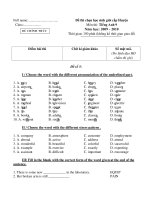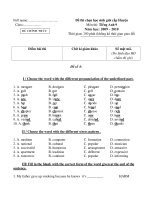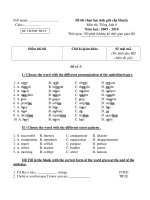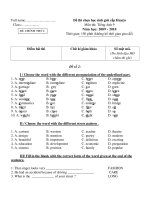Chuyên đề Tiếng Anh 9 - Chuyên đề Reading (phần 4)
Bạn đang xem bản rút gọn của tài liệu. Xem và tải ngay bản đầy đủ của tài liệu tại đây (287.76 KB, 12 trang )
<span class='text_page_counter'>(1)</span><div class='page_container' data-page=1>
<b>Fanpage : </b>
<b>31. Complete the conversation about means of communication, using the </b>
<b>responses (A-H) given. </b>
A. Our messages will be transferred at the speech of light in the future.
B. Smoke was used as a means of communication from one mountain to another.
C. With the invention of stamps.
D. Only a few simple messages could be sent and received with this primitive
method of smoke signals.
E. People carry it together with the identity card, the keys and the wallet.
F. The pigeons could fly to and fro to carry letters.
G. It tells about the means of communication in the past, present, and the future.
H. Carrier pigeon was another means communication to send messages further
away.
<i><b>John:</b></i> Which book are you reading, Hung?
<i><b>Hung:</b></i> (1) _______________________________________________________
<i><b>John:</b></i> Wow, interesting! I think it has changed according to the changes in
technology. What was first used for communication?
<i><b>Hung:</b></i> (2) _______________________________________________________
<i><b>John:</b></i> Maybe people only used smoke to ask for help or something like that.
<i><b>Hung:</b></i> (3) _______________________________________________________
<i><b>John:</b></i> What happened after that?
</div>
<span class='text_page_counter'>(2)</span><div class='page_container' data-page=2>
<b>Fanpage : </b>
<i><b>John:</b></i> I’ve heard about that. The pigeons were trained for this two-way
communication method of letter carrying.
<i><b>Hung: </b></i> Sure. (5) ___________________________________________________
<i><b>John:</b></i> Then people send letters by post.
<i><b>Hung:</b></i> (6) _______________________________________________________
Right? After that, we have Morse codes, telegraphs, telephones, email
with the Internet, and so on.
<i><b>John:</b></i> Now mobiles are the most popular.
<i><b>Hung: </b></i> Yeah. (7) __________________________________________________
<i><b>John:</b></i> And the future? It is not difficult to predict the future of the
communication.
<i><b>Hung: </b></i> (8)
<b>32. Choose the word or phrase among A, B, C or D that best fits the blank </b>
<b>space in the following passage. </b>
During the war, children wore straw hats to (1) themselves from debris.
Houses and schools were bombed and destroyed. Many children were made (2)
and their schools had to be moved around or lessons sometimes had to (3)
after dark to avoid being targeted by heavy bombing. Many schools had its
roof (4) with several layers of straw to withstand the (5) of the
bombs. Life for children was very hard in both the North and South of Viet
Nam during the war.
</div>
<span class='text_page_counter'>(3)</span><div class='page_container' data-page=3>
<b>Fanpage : </b>
Childhood years of children born in the 1960s are (8) . As innocent
children, they went to school (9) straw hats in the sounds of American
jet fighters in the sky and the shots from Vietnamese anti-aircraft guns.
Nowadays, they are proud that they came through those hardships. They had
their heads held (10) walking out of the war.
1. A. protect B. keep C. save D. help
2. A. homemade B. homeless C. homelessness D. homesick
3. A. place B. take place C. be happened D. exist
4. A. cover B. covering C. covered D. being covered
5. A. reasons B. causes C. actions D. impacts
6. A. known B. afraid C. capable D. aware
7. A. care for B. take after C. take care about D. deal
8. A. unfortunate B. unforgettable C. forgettable D. memorably
9. A. wear B. to wear C. wearing D. that wear
10. A. high B. highly C. height D. above
<b>33. Read the passage, and choose the correct answer A, B, C or D for each </b>
<b>question. </b>
<b>Street Food Shoulder Poles on Saigon streets </b>
Street food shoulder pole is familiar with Saigon people throughout many years.
Nowadays it has become a special thing that makes travelers curious. In small
areas of District 1 and District 3, we could count more than 100 vendors who
earned money using shoulder poles. A shoulder pole, also called a carrying
pole, is a <b>yoke</b> of wood or bamboo, used by people to carry a load. The vendors
put their goods in two baskets from each end of the yoke.
</div>
<span class='text_page_counter'>(4)</span><div class='page_container' data-page=4>
<b>Fanpage : </b>
street dust. In a tight space ofone basket, she could mix the ingredients and bake
the cake on a small charcoal which was defended by carton. The ready cakes
were put in other basket.
In the morning or evening, on rainy or sunny day, Saigon streets are marked by
shoulder poles of people from different regions of the country, which has
become a unique part of Saigon. It has been said that it isn’t hard to live in
Saigon if you work hard. With the carrying pole on shoulders, the vendor has
turned it into a “store”. The reason is very simple, they don’t have enough
money to open a real store. Every day these women continue their journey
through Saigon streets under the sun and the rain, selling cheap things or street
foods to earn money and feed their children.
1. A shoulder pole .
A. is the connection between wood and bamboo
B. used to be called a carrying pole
C. is a bar made of wood or bamboo
D. is used to put goods on street vendor’s shoulders
2. Street food shoulder pole is .
A. used by street vendors to carry things
B. a characteristic of District 1 and 3
C. used to make foreign travelers curious
D. a way for passer-by to have food
3. All of the following are true about shoulder poles EXCEPT that .
A. street vendors can bake cakes there
B. the two baskets have the same function
C. they can contain enough things to serve some customers
D. they can be protected from dust
</div>
<span class='text_page_counter'>(5)</span><div class='page_container' data-page=5>
<b>Fanpage : </b>
A. they can help street vendors to sell many things without a store
B. street vendors can support their families with the help of shoulder poles
C. it is a way for street vendors to carry goods around the streets
D. women are marked by unique shoulder poles from different regions
5. The word <b>“yoke” </b>in paragraph 1 is closest in meaning to .
A. a piece of wood that is shaped to fit across a person’s shoulders to carry two
equal loads
B. a wooden bar that is connected to the vehicles or loads so that they can be
pulled away
C. something that connects two things or people, usually in a way that limits
freedom
D. a long piece of wood that is fastened across the necks to pull heavy loads
34<b>. Read the following passage and fill in the blanks with suitable words. </b>
Godolphin and Latymer School for girls is a private school in Hammersmith,
West London. It (1) originally a boy’s school, but became a girls’ (2)
in the early 1900s. The girls didn’t wear a uniform. At thattime, the school
had twelve (3) , an assembly hall, a library, acookery room, a
gymnasium, and three science laboratories for chemistry, physics(4)
botany. The school had its own playing field, described as“lung of
Hammersmith”, (5) the girls could play hockey, tennis,basketball and
cricket. They had (6) play games twice a week,with gym once a
week. There were 328 girls at the school in 1906.
There are now 700 girls aged (7) 11 and 18 at the school.The
younger pupils have to wear a uniform, but girls in the sixth form can
</div>
<span class='text_page_counter'>(6)</span><div class='page_container' data-page=6>
<b>Fanpage : </b>
laboratory, a pottery room, a new gymnasium and an ecology garden. (9)
newest buildings contain ten laboratories for science and technology, a
workshop and darkroom, and art studios. (10) are also improved
facilities for music and drama. The playing field was recently converted into an
all-weather surface for hockey and tennis.
<b>35. Fill in the blank with a suitable word. </b>
Teenagers do not spend as much money as their parents suspect - at least not
according to the findings of a (1) survey. The survey (2) 300
teenagers, 13-18 years old, from all over Britain.
By the time they reach their teens, most children see their weekly (3)
rise dramatically to an amazing national average of £20. Two thirds think
they (4) enough money, but most expect to have to do something to get
it.
Although they have more cash, worry about debt is (5)
among teenagers. Therefore, the majority of children make an effort to (6)
some aside for the future.
Greater access (7) cash among teenagers does not, however,
mean that they are more irresponsible (8) a result. Instead of
wasting (9) pocket money they have on sweets or magazines, the
13-year-old who took part in the survey seem to (10) to the situation by
saving more than half of their cash.
<b>36. Fill in the blank using the words in the box. </b>
<b>sharing </b> <b>sources </b> <b>parts </b> <b>their </b> <b>losing </b>
</div>
<span class='text_page_counter'>(7)</span><div class='page_container' data-page=7>
<b>Fanpage : </b>
Subsidy economy from 1976 to 1986 means all (1) of goods
and raw materials are in the (2) of the central government. The
government coordinated all steps of economy from planning, collecting, and
distributing to (3) . Each person (4) with
standard distributions which depended (5) working level, age, rank
and position in government or professional.
(6) essential supplies had many problems, for example, four people
shared a pair of bicycle tires, or even a blanket. Sometimes one pig was shared
among 20 households, everyone wanted to take the good (7) and
very difficult to divide fairly. Moreover, because of bad storage and
complicated delivery, many supplied foods were in bad condition, such as
broken, rotten or even poisonous. Each family got (8) own rice
booklet shown date and number kilos of rice. During that time, the Vietnamese
had a famous saying, “Your face (9) sad like (10)
the rice booklet”.
<b>37. Read the passage below and decide which answer A, B, C or D fits each </b>
<b>numbered gap. </b>
Teenagers do not spend as much money as their parents suspect - at least not
according to the findings of a (1) survey. The survey (2)
teenagers, 13 – 18 years old, from all over Britain.
By the time they reach their teens, most children see their weekly (3)
</div>
<span class='text_page_counter'>(8)</span><div class='page_container' data-page=8>
<b>Fanpage : </b>
Although they have more cash, worry about debt is (5)
among teenagers. Therefore, the majority of children make an effort to (6)
some aside for the future.
Greater access (7) cash among teenagers does not, however,
mean that they are more irresponsible (8) a result. Instead of
wasting (9) pocket money they have on sweets or magazines, the
13-year-old who took part in the survey seem to (10) to the situation by
saving more than half of their cash.
1. A. latest B. fresh C. late D. recent
2. A. counted B. enclosed C. included D. contained
3. A. bonus B. profit C. allowance D. support
4. A. make B. get C. accept D. earn
5. A. increasing B. building C. gaining D. heightening
6. A. spare B. keep C. put D. save
7. A. from B. along C. to D. with
8. A. for B. in C. like D. as
9. A. which B. what C. the D. whether
10. A. respond B. return C. reply D. answer
<b>38. Read the passage, and choose the correct answer A, B, C or D for each </b>
<b>question. </b>
To preserve and develop traditional craft villages, in recent years, the local
authorities have conducted preservation of four traditional crafts: brocade
weaving, silver carving, blacksmithing, and carpentry to bring about economic
and social efficiency for the development of provincial tourism...
</div>
<span class='text_page_counter'>(9)</span><div class='page_container' data-page=9>
<b>Fanpage : </b>
casting products, textiles of linens of Hmong people. The famous alcohol
villages have found their footholds in the market such as Pho village corn wine
(Bac Ha), Xeo village wine (in Bat Xat commune).
The villages in the province have been associated with tourism spots and
promotetourism development in the community, improve living standards of
many families through their home business, selling handicrafts, brocade
products.
In the past, in the villages in Sa Pa, people mostly make their living in
agriculture, forestry, but now there have been many households getting
involved in tourism activities of the village.
With the aim of preserving and developing traditional village linked to tourism
development, most of the villages have created its own <b>definition</b> for tourists to
learn and explore. In particular, brocade weaving is dominant, serving the needs
of families and tourists. Only in Sa Pa district has 11 embroidery and weaving
villages, in Ta Phin village, and San Sa Ho village with about 1000 households
participating and a number of groups from the district women society, put on
the market each year more than 30,000 metres of fabric. Other districts like Van
Ban, Bac Ha have also formed several embroidery villages, attracting thousands
of workers.
1. We can infer from the passage that tourism has .
A. prevented forests from being cut down
B. found its footholds in the market
C. raised labour income in rural areas
D. made all farmers quit farming
2. Cat Cat village is famous for .
</div>
<span class='text_page_counter'>(10)</span><div class='page_container' data-page=10>
<b>Fanpage : </b>
3. The word “<b>definition”</b> in paragraph 3 is closest in meaning to .
A. quality of being clear B. what tourism means
C. descriptions of features D. explanation of the meaning
4. The purpose of preservation of traditional craft villages is bringing about
.
A. the start of tourism
B. economic and social development
C. the clear models of traditional villages
weaving 30,000 metres of fabric
5. All of the following are true EXCEPT that .
A. other districts should start preserving their craft like Sa Pa
B. preservation of traditional crafts can be associated with tourism
C. brocade weaving has become the most important craft in Sa Pa and nearby
districts
D. local people can sell handicrafts, brocade products to tourists
<b>39 Fill each of the numbered blanks in the following passage. Use only one </b>
<b>word in each space. </b>
Australia is a huge country and it has a lot of different kinds of (1)
. In the past, the Aboriginal people of Australia ate animals like crocodiles
and some insects like the witchetty grub. Aboriginal Australians travelled
around the Australian countryside, or ‘bush’, to find food.
When the first British and Irish people moved to Australia in the 1830s, they
brought sheep and cows from Europe. They also brought traditional Englishand
Irish recipes. Many of these (2) , like fish and chips and (3)
</div>
<span class='text_page_counter'>(11)</span><div class='page_container' data-page=11>
<b>Fanpage : </b>
pies, are still popular today. They also created new Australian recipes
such as the pavlova (a fruit dessert - named after a Russian dancer) and damper
(a bread cooked in the bush).
After 1945, a lot of people came to live in Australia from countries like Italy,
Germany, Greece, Thailand and India. They brought recipes with them and
Australians began to eat and drink different things. People started to drink (4)
coffee and eat Mediterranean and Asian food.
A lot of modern Australians love (5) with fresh food. They
often cook food on (6) in their gardens or on the beach. Today more
people also eat (7) food like kangaroo and (8)
. Mark Olive, an Aboriginal chef, has a popular TV (9) programme
about traditional; (10) food. There are always new recipes to try in
Australia!
<b>40. Choose the word or phrase among A, B, c or D that best fits the blank </b>
<b>space in the following passage. </b>
Humans have a long history of eating insects, and it turns out that they can be a
very (1) part of a person’s regular (2) . Insects
have a lot of protein, and they are often easier to catch than (3)
animals. Therefore, it is no wonder that when our ancient (4)
saw some tasty worms or grabs wiggling on the ground, they made a quick
snack of them.
</div>
<span class='text_page_counter'>(12)</span><div class='page_container' data-page=12>
<b>Fanpage : </b>
get past the (6) that you are eating a cricket, it will crunch in your mouth
just like a corn chip!
For a lot of people, however, it is difficult to get (7) the fear of eating
insects. People tend to see insects as invaders, especially when they are
crawling on the food that we are about to ear. (8) being able to eat
insects (9) feeling disgusted is cultural. Some people cannot
eat French cheese or stinky tofu because they weren’t brought up doing so. To
many of us, insects fail right into that category, making it difficult to even try
them.
If (10) the chance, though, be courageous, insects can be nutritious
and tasty, so long as you can get over the “yuck” factor.
1. A. nutrition B. nutritious C. nutritions D. nutritiously
2. A. health B. fitness C. diet D. balance
3. A. prey B. pray C. eat D. digest
4. A. acquaints B. relatives C. ancestors D. offspring
5. A. insects B. animals C. herbs D. cattle
6. A. true B. exact C. fact D. reality
7. A. up B. over C. down D. on
8. A. However B. Although C. Meanwhile D. Therefore
9. A. without B. in C. far D. on
</div>
<!--links-->
Đề thi chọn học sinh giỏi cấp tiếng anh 9 trường nguyễn du ppt
- 17
- 902
- 28








